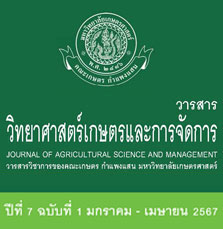เครื่องหมายดีเอ็นเอที่สัมพันธ์กับลักษณะการพักตัวของเมล็ดในถั่วซอมบี้ [Vigna vexillata (L.) A. Rich]
คำสำคัญ:
ถั่วซอมบี้, Vigna vexillata, การพักตัวของเมล็ด, แผนที่ยีน, QTLบทคัดย่อ
การลดลงหรือการสูญเสียการพักตัวของเมล็ดเป็นลักษณะที่เกิดขึ้นจากปลูกเลี้ยงพืชในกลุ่มธัญพืชและพืชวงศ์ถั่ว การสูญเสียการพักตัวของเมล็ดทำให้การงอกมีความสม่ำเสมอ ซึ่งเป็นประโยชน์ต่อการปลูกพืช แม้การพักตัวของเมล็ดจะส่งผลกระทบต่อการปลูกพืช แต่ก็อาจมีประโยชน์สำหรับใช้แก้ปัญหาการงอกของเมล็ดก่อนการเก็บเกี่ยวเนื่องจากฝนตกและความชื้นที่มีมากเกินไป ถั่วซอมบี้ (zombi; Vigna vexillata (L.) A. Rich) เป็นพืชที่ปรับตัวให้เข้ากับสภาพอากาศและสิ่งแวดล้อมได้ดี แต่มีการศึกษาวิจัยน้อย การศึกษาครั้งนี้มีวัตถุประสงค์เพื่อค้นหาเครื่องหมายดีเอ็นเอที่สัมพันธ์กับลักษณะการพักตัวของเมล็ดในถั่วซอมบี้ ดำเนินการโดยใช้ประชากรชั่วรุ่นที่ 2 (F2) จำนวน 94 ต้น ของคู่ผสม TVNu240 (พันธุ์ปลูก) ´ TVNu1623 (พันธุ์ป่า) พบว่า ค่าอัตราพันธุกรรมแบบกว้างของการพักตัวของเมล็ดมีค่าเท่ากับ 62.99 % การวิเคราะห์ bulk segregant analysis พบว่า เครื่องหมายเอสเอสอาร์ VvSSR-39 VvSSR-48 และ VvSSR-71 สัมพันธ์กับลักษณะการพักตัวของเมล็ด การวิเคราะห์การถดถอยเชิงเดี่ยวในประชากร F2พบว่า เครื่องหมายเหล่านี้อธิบายความแปรปรวนของลักษณะการพักตัวของเมล็ดได้ 15.15 % 13.06 % และ 11.49 % ตามลำดับ การสร้างแผนที่พันธุกรรมและการวิเคราะห์ QTL ในประชากร F2 พบ QTL ที่ควบคุมการพักตัวของเมล็ดจำนวน 1 ตำแหน่ง วางตัวอยู่ระหว่างเครื่องหมาย VvSSR-39 และ VvSSR-71 และอธิบายความแปรปรวนของลักษณะการพักตัวของเมล็ดได้ 18.29 % ผลของการศึกษานี้เป็นประโยชน์ในการค้นหายีนที่ควบคุมการพักตัวของเมล็ดในถั่วซอมบี้ต่อไป
เอกสารอ้างอิง
Amkul, K., L. Wang, P. Somta, S. Wang and X. Cheng. 2019. Construction of a high density linkage map and genome dissection of bruchid resistance in zombi pea (Vigna vexillata (L.) A. Rich). Scientific Reports 9: 1-10.
Amkul, K., P. Somta, K. Laosatit and L. Wang. 2020. Identification of QTLs for domestication-related traits in zombi pea [Vigna vexillata (L.) A. Rich.], a lost crop of Africa. Frontiers in Genetics 11: 803.
Birch, A.N.E., L.E. Fellow, S.V. Evans and K. Doherty .1986. Para-Aminophenylalanine in Vigna: possible taxonomic and ecological significance as a seed defence against bruchids. Phytochemistry 25: 2745-2749.
Chandel, K.P.S., R.K. Arora and B.S. Joshi. 1972. Vigna capensis Walp. (V. vexillata) an edible root legume. Current Science 41: 537.
Chai, M., C. Zhou, I. Molina, C. Fu, J. Nakashima, G. Li, W. Zhang, J. Park, Y. Tang, Q. Jiang and Z.Y. Wang. 2016. A class II KNOX gene, KNOX4, controls seed physical dormancy. Proceedings of the National Academy of Sciences of the United States of America 113: 6997-7002.
Dachapak, S., P. Somta, S. Poonchaivilaisak, T. Yimram and P. Srinives. 2017. Genetic diversity and structure of the zombi pea (Vigna vexillata (L.) A. Rich.) gene pool based on SSR marker analysis. Genetica 145: 189-200.
Finch-Savage, W.E. and G. Leubner-Metzger. 2006 Seed dormancy and the control of germination. New Phytologist 171: 501-23.
Gomathinayagam, P., S. Ganeshram, R. Rathnaswamy and N.M. Ramaswamy. 1998. Interspecific hybridization between Vigna unguiculata (L.) Walp. and Vigna vexillata (L.) A. Rich. through in vitro embryo culture. Euphytica 102: 203-209.
Jackai, L.E.N. and S. Oghiakhe. 1989. Pod wall trichomes and resistance of two wild cowpea, Vigna vexillata, accessions to Maruca testualis (Geyer) (Lepidoptera: Pyralidae) and Clavigralla tomentosicollis Stal (Hemiptera: Coreidae). Bulletin of Entomological Research 79: 595-605
Karuniawan, A., A. Iswandi, P.R. Kale, J. Heinzemann and W.J. Grüneberg. 2005. Vigna vexillata (L.) A. Rich. cultivated as a root crop in Bali and Timor. Genetic Resources and Crop Evolution 53: 213-217.
Kosambi, D. 1944. The estimation of map distance from recombination values. Annals of Eugenics 12: 172-175.
Laosatit, K., K. Amkul, T.Yimram, J. Chen, Y. Lin, X. Yuan, L. Wang, X. Chen and P. Somta. 2022. A Class II KNOX gene, KNAT7-1, regulates physical seed dormancy in mungbean [Vigna radiata (L.) Wilczek]. Frontiers in Plant Science 13: 1-14.
Lee, J.S., D. Chebotarov, K.L. McNally, V. Pede, T.D. Setiyono, R. Raquid, W.J. Hyun, J.U. Jeung, A. Kohli and Y. Mo. 2021. Novel sources of pre-harvest sprouting resistance for Japonica rice improvement. Plants 10: 1709.
Li, H., G. Ye and J. Wang. 2007. A modified algorithm for the improvement of composite interval mapping. Genetics 175: 361-374.
Lodhi, M.A., G.N. Ye, N.F. Weeden and B.I. Reisch. 1994. A simple and efficient method for DNA extraction from grapevine cultivars and Vitis species. Plant Molecular Biology 12: 6-13.
Meng, L., H. Li, L. Zhang and J. Wang. 2015. QTL IciMapping: Integrated software for genetic linkage map construction and quantitative trait locus mapping in biparental populations. Crop Journal 3: 269-283.
Michelmore, R.W., I. Paran and R.V. Kesseli. 1991. Identification of markers linked to disease resistance genes by bulk segregant analysis: a rapid method to detect markers in specific genomic regions using segregating populations. Proceedings of the National Academy of Sciences of the United States of America 88: 9828-9832.
Nonogaki, H. 2014. Seed dormancy and germination emerging mechanisms and new hypotheses. Frontiers in Plant Science 5: 233.
Panzeri, D., W.G. Nissim, M. Labra and F. Grassi. 2022. Revisiting the domestication process of African Vigna species (Fabaceae): background, perspectives and challenges. Plants 11: 532.
Wang, M., W. Li, C. Fang, F. Xu, Y. Liu, Z. Wang, R. Yang, M. Zhang, S. Liu, S. Lu, T. Lin, J. Tang, Y. Wang, H. Wang, H. Lin, B. Zhu, M. Chen, F. Kong, B. Liu, D. Zeng, S.A. Jackson, C. Chu and Z. Tian. 2018. Parallel selection on a dormancy gene during domestication of crops from multiple families. Nature Genetics 50: 1435-1441.






